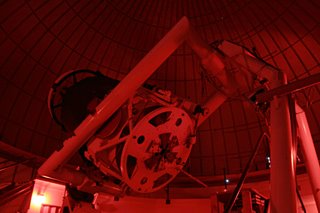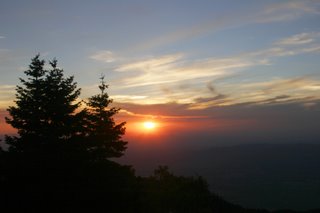Click on the images to see a larger version.
All of the images on this site are copyrighted material and may not be used without written permission of the owner. If you would like to use or purchase prints any of these images, please visit Full Moon Photography for more information.
All of the images here have been reduced in size to at least 1/6 the original and then compressed for display.
Friday, September 29, 2006
Thursday, September 28, 2006
Wednesday, September 27, 2006
Star Trails over an X-Ray dome
 After taking a long break, here's a shot I got last week of the Schmidt dome using the simplest technique of astrophotography. Set the camera on a tripod, point it at something interesting and open the shutter. When I started this exposure, Orion was rising in the east (Seen to the upper right) and Sirius, the brightest star in our sky, is seen as the bright line at lower right. As the dome rotated, the open shutter was positioned at times so the camera could "look in", giving that slightly X-ray appearance.
After taking a long break, here's a shot I got last week of the Schmidt dome using the simplest technique of astrophotography. Set the camera on a tripod, point it at something interesting and open the shutter. When I started this exposure, Orion was rising in the east (Seen to the upper right) and Sirius, the brightest star in our sky, is seen as the bright line at lower right. As the dome rotated, the open shutter was positioned at times so the camera could "look in", giving that slightly X-ray appearance.Canon 20D - 59 minutes, 20mm @ f/4.5, ISO 400
Tuesday, September 19, 2006
Red Light District
 One of the day crew leaves the Bigelow Station early in the evening after stopping by to get the heat in the dorm turned back on. The nights on top of the Catalinas are starting to get chilly again as Autumn begins. The brake lights on his truck illuminate the domes as he slowly heads down the driveway and out the gate. Canon 20D - 30 seconds, 20mm @ f/1.8, ISO 800
One of the day crew leaves the Bigelow Station early in the evening after stopping by to get the heat in the dorm turned back on. The nights on top of the Catalinas are starting to get chilly again as Autumn begins. The brake lights on his truck illuminate the domes as he slowly heads down the driveway and out the gate. Canon 20D - 30 seconds, 20mm @ f/1.8, ISO 800
Monday, September 18, 2006
Mt. Bigelow Domes
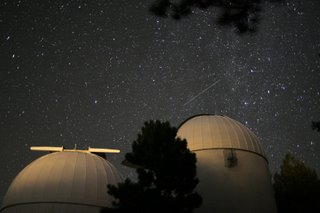 A view almost directly north at the Mt. Bigelow Station. The domes are illuminated by the lights of Tucson 6000 feet below and an unidentified satellite slices through the sky over the Schmidt dome.
A view almost directly north at the Mt. Bigelow Station. The domes are illuminated by the lights of Tucson 6000 feet below and an unidentified satellite slices through the sky over the Schmidt dome.The 61" was busy observing variable stars while the Schmidt continued its yeoman service discovering Near Earth Asteroids. In just this week, the Schmidt discovered about 20 new NEOs, 2 new comets and an object that very well may be the Apollo 10 Lunar Module "Snoopy". Further study will be needed before we will know if it is in fact Snoopy. (Snoopy is also the only Lunar Module to fly in space that is still intact. All the others have either crashed onto the moon's surface or burned up in Earth's atmosphere.)
A great start to the 2006 - 2007 observing season!
Canon 20D - 30 seconds, 20mm @ f/1.8, ISO 800
Wednesday, September 13, 2006
John Brown, the Abolitionist?
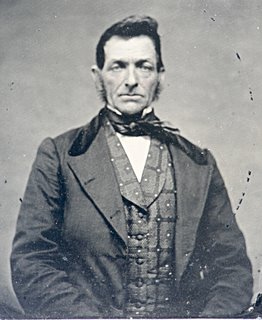 This image is an ambrotype, which was a photographic process that became popular around 1850. It was much less expensive than the daguerreotype and very quickly replaced it. With this process, the image was made in the camera on a glass plate and then partially developed. When the glass negative is placed against a dark background it appears to be a positive, due to the way light reflects off of the silver salts.
This image is an ambrotype, which was a photographic process that became popular around 1850. It was much less expensive than the daguerreotype and very quickly replaced it. With this process, the image was made in the camera on a glass plate and then partially developed. When the glass negative is placed against a dark background it appears to be a positive, due to the way light reflects off of the silver salts.Close inspection of ambrotypes reveal that they are different in appearance than more modern processes, but they don't have that magical quality of a daguerreotype.
The person I purchased this image from stated that the person he had bought it from thought it is an early image of John Brown, the famous abolitionist. There is no evidence that this is true, but I have closely examined known images of John Brown, taken later in his life, and there is a very striking similarity of his features and this ambrotype.
I'd be very interested in hearing from people who are more familiar with John Brown and his images and their thoughts about this image.
Thursday, September 07, 2006
June Morning Dawn
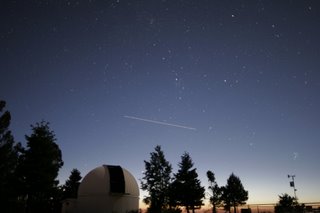 While going through my archives for images to be used in our gallery on our survey's website, I came across this image of the 60" on Mt. Lemmon. It is from an animation series that was taken just before dawn in late June. An early morning flight is seen streaking eastward behind the dome, the "Seven Sisters" are rising in the east and the dome is illuminated by the moon. Canon 20D, 30 seconds, 20mm @ f/1.8, ISO 400
While going through my archives for images to be used in our gallery on our survey's website, I came across this image of the 60" on Mt. Lemmon. It is from an animation series that was taken just before dawn in late June. An early morning flight is seen streaking eastward behind the dome, the "Seven Sisters" are rising in the east and the dome is illuminated by the moon. Canon 20D, 30 seconds, 20mm @ f/1.8, ISO 400
Wednesday, September 06, 2006
Aircraft too!
 We are lucky in that very very few aircraft foul our survey images. Considering how wide the field of view is on the Schmidt, that is pretty surprising. The trail here is clearly an aircraft flying above the Santa Catalinas. The red flashing beacon leaving a trail of dots along its path in the image.
We are lucky in that very very few aircraft foul our survey images. Considering how wide the field of view is on the Schmidt, that is pretty surprising. The trail here is clearly an aircraft flying above the Santa Catalinas. The red flashing beacon leaving a trail of dots along its path in the image.Canon 20D -30 seconds, 20mm @ f/1.8, ISO 200
Saturday, September 02, 2006
Iridium Flash
 The antenna arrays on the commercial Iridium satellites reflect sunlight in such a concentrated beam, that they can momentarily be the brightest objects in the sky next to the Sun and the Moon. About 20 minutes after the previous image of the Lacrosse 5 satellite passage posted yesterday, Iridium 45 passed overhead and the flash of light reached -6 magnitude as seen from Mt. Bigelow.Canon 20D - 30 seconds, 20mm @ f/1.8, ISO 200
The antenna arrays on the commercial Iridium satellites reflect sunlight in such a concentrated beam, that they can momentarily be the brightest objects in the sky next to the Sun and the Moon. About 20 minutes after the previous image of the Lacrosse 5 satellite passage posted yesterday, Iridium 45 passed overhead and the flash of light reached -6 magnitude as seen from Mt. Bigelow.Canon 20D - 30 seconds, 20mm @ f/1.8, ISO 200
Friday, September 01, 2006
Eye in the Sky
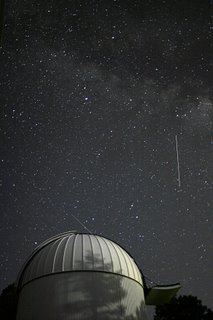 As the sun set over Tucson, man-made satellites silently passed overhead, as they do almost everywhere on Earth. Many can be seen just after sunset or just before sunrise every day. The bright one visible as the nearly verticle line in this image is a U. S. military spy satellite called "Lacrosse 5". This satellite was heading south in its orbit. Another, unidentified satellite can be seen heading to the north east, as a faint line soming out of the top of the Schmidt dome. The crescent moon illuminates the scene. Canon 20D - 20mm @ f/1.8, ISO 200
As the sun set over Tucson, man-made satellites silently passed overhead, as they do almost everywhere on Earth. Many can be seen just after sunset or just before sunrise every day. The bright one visible as the nearly verticle line in this image is a U. S. military spy satellite called "Lacrosse 5". This satellite was heading south in its orbit. Another, unidentified satellite can be seen heading to the north east, as a faint line soming out of the top of the Schmidt dome. The crescent moon illuminates the scene. Canon 20D - 20mm @ f/1.8, ISO 200
